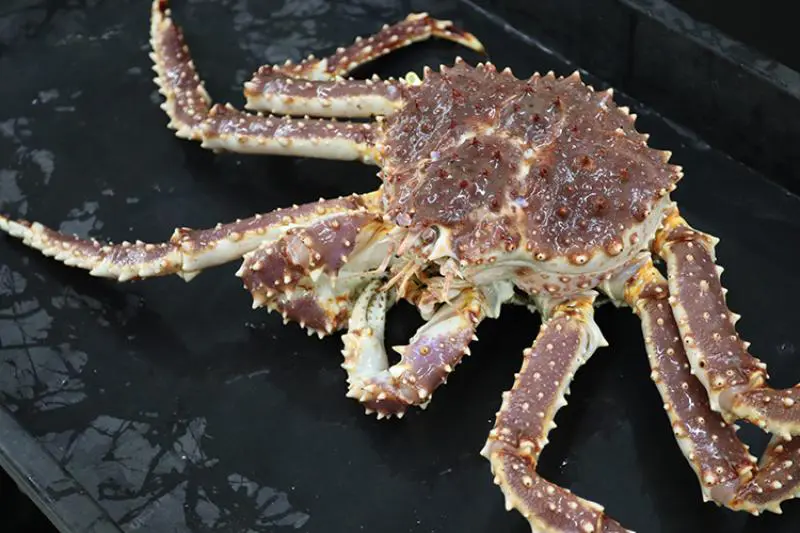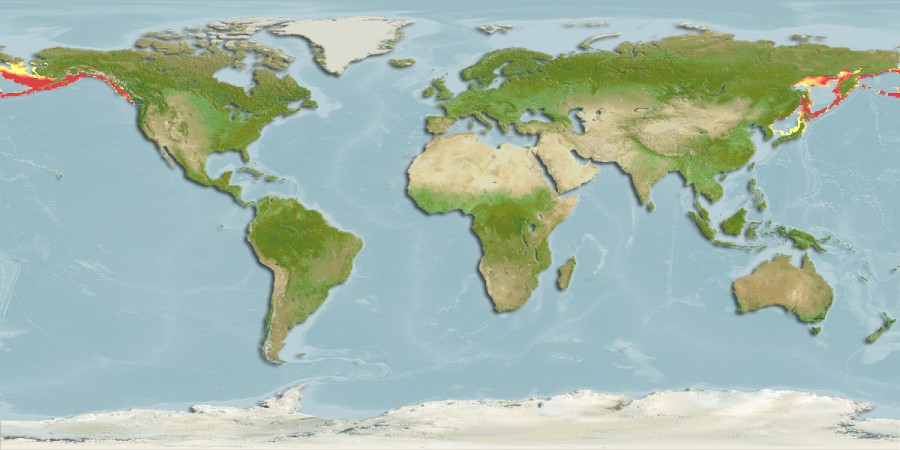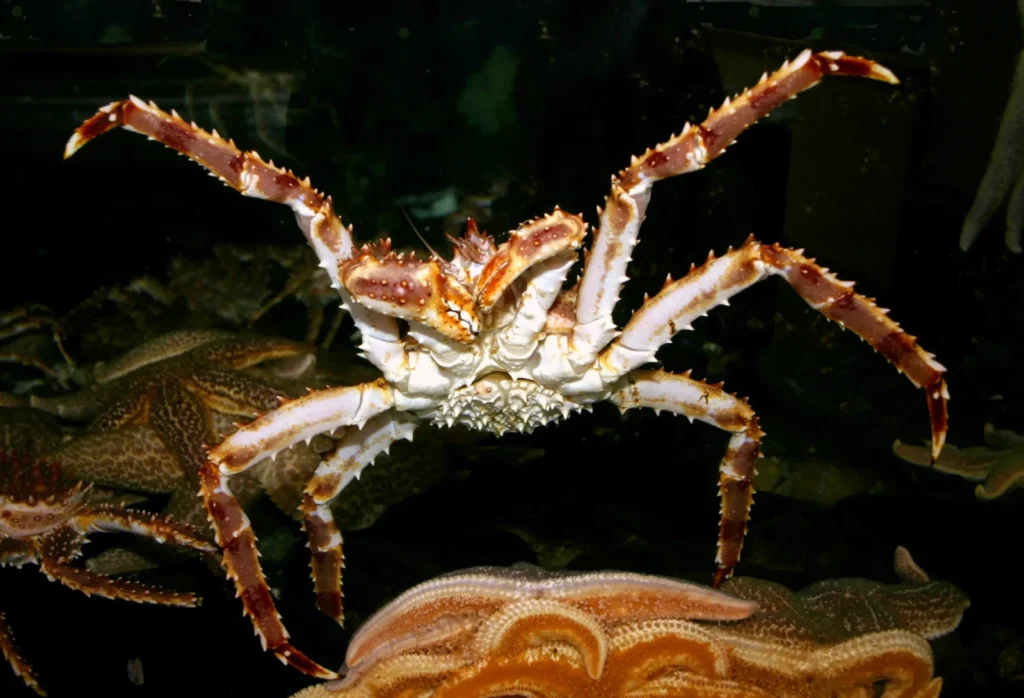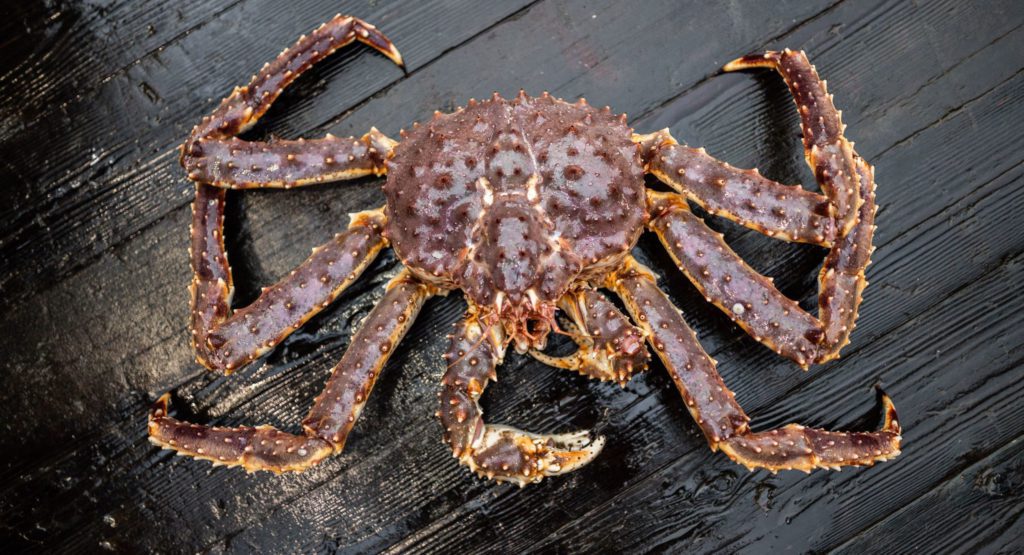The Kamchatka crab (Paralithodes camtschaticus), also known as the red king crab, is one of the largest and most famous representatives of ten-legged crustaceans in the world. Its impressive size, fleshy limbs, and high nutritional value have made it an object of fishing and culinary passion. However, its striking appearance hides a complex biology, important ecological importance, and problems associated with its introduction into new ecosystems.

Classification
• Kingdom: Animals (Animalia)
• Phylum: Arthropoda (Arthropoda)
• Class: Crustaceans (Malacostraca)
• Order: Decapoda
- Family: Lithodidae
- Genus: Paralithodes
- Species: Kamchatka crab (Paralithodes camtschaticus)
Appearance
📏 Sizes
- Leg span: up to 1.8 m
- Body (carapace): up to 28 cm wide
- Weight: up to 12 kg, although the usual weight is 4-7 kg
🎨 Description
- Carapace is rough, covered with sharp outgrowths and thorns
- Body color varies: from red-brown to purple above, whitish below
- It has ten limbs: five pairs, one of which is a large claw (in males, one claw is usually larger)
- Eyes small, on stalks; antennae short

Range and habitat
🌍 Area
- Natural range: Northwestern Pacific Ocean, in particular near Kamchatka, the Kuril Islands, the Sea of Okhotsk and the Bering Sea
- Introduced into the Barents Sea (in the 1960s and 1970s by the Soviet Union), it has now spread to the shores of Norway
🌿 Living environment
- Prefers cold waters at depths from 20 to 300 m (sometimes up to 400 m)
- Grows on muddy, sandy or rocky soils
- Leads a bottom-dwelling lifestyle, but makes seasonal migrations
Behavior
🔄 Migrations
- It has a complex life cycle with seasonal migrations: in spring it moves closer to the shore for molting and breeding, in autumn - to deeper waters
- In the Barents Sea, these migrations have caused massive dispersal of the species

🛡️ Defensive behavior
- Young crabs often hide among algae or under rocks
- In case of danger, they can resort to aggressive claw defense
- They form clusters (aggregations), especially during migrations
Food
🍽️ Diet
- Omnivorous - consumes mollusks, worms, other crustaceans, sea urchins, carrion and even small fish
- Larvae and juveniles feed on plankton
- Has powerful jaws for crushing hard shells
⚖️ Impact on the ecosystem
- In the Barents Sea, it has caused changes in the trophic chain: a decrease in the populations of local mollusks and urchins
- May displace native species of crabs and crustaceans
Reproduction
🦪 Sexual maturation and reproduction
- Reaches sexual maturity at the age of 5-7 years
- Mating occurs after the female molts
- The female lays up to 500 thousand eggs, which she attaches to the abdominal legs
⏳ Development
- Eggs develop up to 12 months, depending on water temperature
- After hatching, the larvae spend up to 2-3 months in plankton, going through several stages of metamorphosis
- Young crabs gradually switch to a bottom-dwelling lifestyle
Type and threat status
⚠️ Protection status
- IUCN: not listed as vulnerable or endangered
- In the natural range, controlled fishing; in the Barents Sea, fishing is allowed due to the invasive nature of the species
🛑 Threats
- Overfishing in some regions can lead to localized depletion of populations
- Climate change may affect habitat
- Pollution of marine ecosystems
Economic importance
💰 Fishing
- One of the most valuable commercial crab species in the world
- Meat is considered a delicacy - tender, sweet, high in protein
- Caught using traps (crab traps)

🌐 Introduction to the Barents Sea
- In the 1960s, the USSR launched an introduction project to create a new industrial resource
- As a result, the crab has spread over a vast territory and is now actively fished in Norway, Russia, and even enters fjords
- Disputes between ecologists and fishermen: on the one hand, an invasive species, on the other, a profitable resource
Interesting facts
✔️ The Kamchatka crab has "asymmetrical claws" - one massive for breaking shells, the other thinner for precise gripping
✔️ After molting, the crab's body can grow up to 25% - this is a vital growth process
✔️ There are cases of "cannibalism" among young crabs during the period of food shortage
✔️ Some crabs can live up to 20 years in the wild
✔️ Because of its size, it is sometimes called a "sea spider"
Conclusion
The Kamchatka crab is not just a culinary star, but a complex creature with an interesting biology and a major role in marine ecosystems. Its adaptation to harsh conditions, seasonal migrations, and aggressive expansion into new waters make it a unique example of survival and a challenge for biodiversity. Humanity should learn from such examples to ensure that the balance between resource use and nature conservation is not upset.